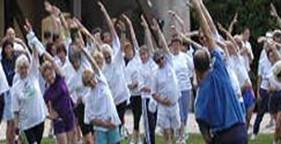|
|
Aging Blood Vessels Adapt to Exercise
October 6, 2004, Senior Journal

Image
from "Senior Journal"
When we exercise, our heart and breathing rates rise rapidly and blood vessels in our limbs dilate in order to deliver more oxygenated blood to our working muscle cells. The rapid rise in blood flow to the periphery -- especially to the legs -- can create a "heady" feeling, which reflects a temporary drop in blood pressure. This stimulates sympathetic nerves throughout the body to release substances that constrict blood vessels, even those vessels that feed working muscles.
Blood vessels in our leg muscles must respond to both dilating and constricting substances to meet the competing demands of muscle oxygen delivery and maintenance of bodily blood pressure, so we don't faint! It's a balancing act that could change with advancing age.
David Proctor and Urs Leuenberger and physiology student Dennis Koch, researchers at Pennsylvania State University and Hershey Medical Center, studied this possibility by manipulating the activity of the sympathetic nervous system in healthy older and younger men undergoing a moderate level of leg (cycling) exercise. They used a simple, but powerful sympathetic stimulus -- plunging a hand into a bucket of ice while still cycling -- and compared the blood vessel reactions in the legs of both age groups.
Leg blood supply in old age important to maintain lifestyle
Results of the Proctor-Leuenberger-Koch study suggest that the mechanisms controlling blood vessel "tone" in exercising muscles may be altered by age in humans. "The augmented constrictor response seen in legs of older men could be a compensatory mechanism for their reduced level of cardiac output during exercise," they reported. In other words, older adults may require a higher level of vascular "restraint" to preserve systemic blood pressure during exercise, Proctor said : "We expected the blood vessels in the older men to constrict less (relative to younger men) during cold stimulation, based on previous research in older animals and humans under resting conditions," Proctor said. But leg vessels of the older men constricted more, perhaps as a compensation for their reduced level of cardiac output. This indicates that the balance between vasodilatation and vasoconstriction in exercising muscle may change with age.
Proctor noted that his laboratory group "is one of the first to systematically study the impact of aging on blood flow to exercising muscle in healthy humans." It's important to study how healthy people age, he noted, "because keeping our rapidly expanding older population healthy will reduce the burden on our health-care system" as well as contribute to enhanced independence and quality of life in these individuals. Understanding the mechanisms by which blood flow to exercising muscles is altered with advancing age will also help us target interventions aimed at improving exercise tolerance in older adults, he said.
Next steps and funding : The researchers will be conducting similar experiments in women (both on estrogen replacement and not). They plan to study the mechanisms underlying age-related changes in vascular responsiveness to sympathetic stimulation; and to examine the importance of sympathetic outflow in regulating vascular tone and oxygen delivery to exercising muscles. Research is supported by the National Institute on Aging.
|
|



